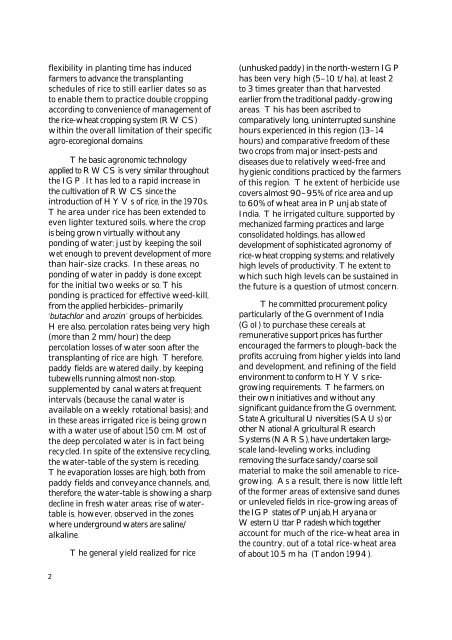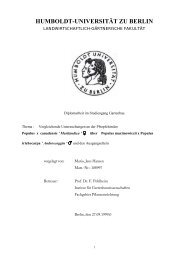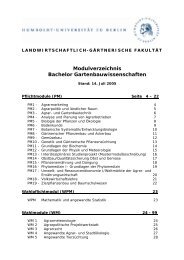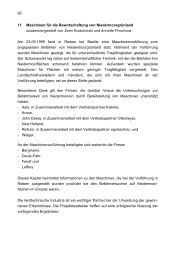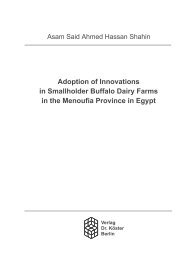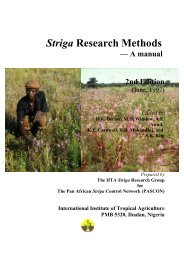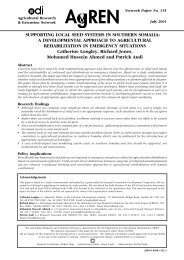Rice-Wheat Cropping Systems of the Indo-Gangetic Plain of India
Rice-Wheat Cropping Systems of the Indo-Gangetic Plain of India
Rice-Wheat Cropping Systems of the Indo-Gangetic Plain of India
You also want an ePaper? Increase the reach of your titles
YUMPU automatically turns print PDFs into web optimized ePapers that Google loves.
flexibility in planting time has induced<br />
farmers to advance <strong>the</strong> transplanting<br />
schedules <strong>of</strong> rice to still earlier dates so as<br />
to enable <strong>the</strong>m to practice double cropping<br />
according to convenience <strong>of</strong> management <strong>of</strong><br />
<strong>the</strong> rice-wheat cropping system (RWCS)<br />
within <strong>the</strong> overall limitation <strong>of</strong> <strong>the</strong>ir specific<br />
agro-ecoregional domains.<br />
The basic agronomic technology<br />
applied to RWCS is very similar throughout<br />
<strong>the</strong> IGP. It has led to a rapid increase in<br />
<strong>the</strong> cultivation <strong>of</strong> RWCS since <strong>the</strong><br />
introduction <strong>of</strong> HYVs <strong>of</strong> rice, in <strong>the</strong> 1970s.<br />
The area under rice has been extended to<br />
even lighter textured soils, where <strong>the</strong> crop<br />
is being grown virtually without any<br />
ponding <strong>of</strong> water; just by keeping <strong>the</strong> soil<br />
wet enough to prevent development <strong>of</strong> more<br />
than hair-size cracks. In <strong>the</strong>se areas, no<br />
ponding <strong>of</strong> water in paddy is done except<br />
for <strong>the</strong> initial two weeks or so. This<br />
ponding is practiced for effective weed-kill,<br />
from <strong>the</strong> applied herbicides–primarily<br />
‘butachlor and arozin’ groups <strong>of</strong> herbicides.<br />
Here also, percolation rates being very high<br />
(more than 2 mm/hour) <strong>the</strong> deep<br />
percolation losses <strong>of</strong> water soon after <strong>the</strong><br />
transplanting <strong>of</strong> rice are high. Therefore,<br />
paddy fields are watered daily, by keeping<br />
tubewells running almost non-stop,<br />
supplemented by canal waters at frequent<br />
intervals (because <strong>the</strong> canal water is<br />
available on a weekly rotational basis); and<br />
in <strong>the</strong>se areas irrigated rice is being grown<br />
with a water use <strong>of</strong> about 150 cm. Most <strong>of</strong><br />
<strong>the</strong> deep percolated water is in fact being<br />
recycled. In spite <strong>of</strong> <strong>the</strong> extensive recycling,<br />
<strong>the</strong> water-table <strong>of</strong> <strong>the</strong> system is receding.<br />
The evaporation losses are high, both from<br />
paddy fields and conveyance channels, and,<br />
<strong>the</strong>refore, <strong>the</strong> water-table is showing a sharp<br />
decline in fresh water areas; rise <strong>of</strong> watertable<br />
is, however, observed in <strong>the</strong> zones<br />
where underground waters are saline/<br />
alkaline.<br />
2<br />
The general yield realized for rice<br />
(unhusked paddy) in <strong>the</strong> north-western IGP<br />
has been very high (5–10 t/ha), at least 2<br />
to 3 times greater than that harvested<br />
earlier from <strong>the</strong> traditional paddy-growing<br />
areas. This has been ascribed to<br />
comparatively long, uninterrupted sunshine<br />
hours experienced in this region (13–14<br />
hours) and comparative freedom <strong>of</strong> <strong>the</strong>se<br />
two crops from major insect-pests and<br />
diseases due to relatively weed-free and<br />
hygienic conditions practiced by <strong>the</strong> farmers<br />
<strong>of</strong> this region. The extent <strong>of</strong> herbicide use<br />
covers almost 90–95% <strong>of</strong> rice area and up<br />
to 60% <strong>of</strong> wheat area in Punjab state <strong>of</strong><br />
<strong>India</strong>. The irrigated culture, supported by<br />
mechanized farming practices and large<br />
consolidated holdings, has allowed<br />
development <strong>of</strong> sophisticated agronomy <strong>of</strong><br />
rice-wheat cropping systems; and relatively<br />
high levels <strong>of</strong> productivity. The extent to<br />
which such high levels can be sustained in<br />
<strong>the</strong> future is a question <strong>of</strong> utmost concern.<br />
The committed procurement policy<br />
particularly <strong>of</strong> <strong>the</strong> Government <strong>of</strong> <strong>India</strong><br />
(GoI) to purchase <strong>the</strong>se cereals at<br />
remunerative support prices has fur<strong>the</strong>r<br />
encouraged <strong>the</strong> farmers to plough-back <strong>the</strong><br />
pr<strong>of</strong>its accruing from higher yields into land<br />
and development, and refining <strong>of</strong> <strong>the</strong> field<br />
environment to conform to HYVs ricegrowing<br />
requirements. The farmers, on<br />
<strong>the</strong>ir own initiatives and without any<br />
significant guidance from <strong>the</strong> Government,<br />
State Agricultural Universities (SAUs) or<br />
o<strong>the</strong>r National Agricultural Research<br />
<strong>Systems</strong> (NARS), have undertaken largescale<br />
land-leveling works, including<br />
removing <strong>the</strong> surface sandy/coarse soil<br />
material to make <strong>the</strong> soil amenable to ricegrowing.<br />
As a result, <strong>the</strong>re is now little left<br />
<strong>of</strong> <strong>the</strong> former areas <strong>of</strong> extensive sand dunes<br />
or unleveled fields in rice-growing areas <strong>of</strong><br />
<strong>the</strong> IGP states <strong>of</strong> Punjab, Haryana or<br />
Western Uttar Pradesh which toge<strong>the</strong>r<br />
account for much <strong>of</strong> <strong>the</strong> rice-wheat area in<br />
<strong>the</strong> country, out <strong>of</strong> a total rice-wheat area<br />
<strong>of</strong> about 10.5 m ha (Tandon 1994).


